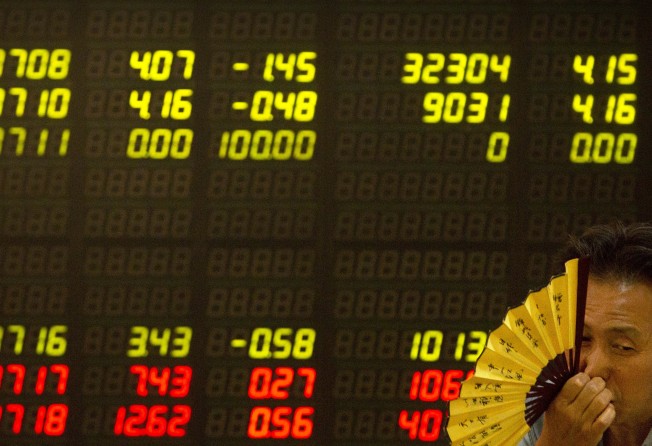As trade war hits, China’s focus should be on steadying growth, and breaking the stop-go fiscal policy cycle
Chen Zhao says Beijing has shown a trend towards tightening liquidity and credit at unfortunate times, leading to the 2015-16 market slump that forced leaders to drastically reverse course. To maintain growth and encourage proper investment, Beijing should focus on reflation, especially given trade tensions with the US

Chinese financial markets look precarious, with both stock prices and the yuan falling precipitously. Many blame the renewed yuan weakness on trade tensions with the United States. I am not so sure. China’s total exports to the US account for 3.5 per cent of gross domestic product. In the highly unlikely event that these exports are halved by higher tariffs, the net impact on the Chinese economy would still be very manageable.
Therefore, the weakening financial markets in China must have been caused by other factors. The Chinese government has been trying to deleverage the economy ever since growth started to accelerate in early 2016. While the People’s Bank of China has tightened liquidity and credit supply aggressively, the central government has also actively cut back fiscal stimulus since early this year.
Furthermore, such policy tightening has taken place at a time when the Chinese currency has been strengthening substantially for the past 12 months. For example, prior to its recent fall, the yuan had risen more than 7 per cent in trade-weighted terms since mid-2017 and 11 per cent against the dollar since the beginning of 2018.
The combination of tight monetary and fiscal policy, together with a strong and expensive yuan, has quickly eroded China’s economic growth. Total social financing, the broadest measure of credit creation, has been contracting.
This has caused broad-based economic weakness: real fixed-asset investment, which is adjusted for inflation, has flirted with contraction for the past few months and retail sales growth has also fallen precipitously lately.
In fact, the Chinese government made similar policy mistakes in 2015, when authorities erroneously tightened credit supply and fiscal policy aggressively at a time of a very strong yuan but a weakening global economy.
This policy combination created severe downward pressures on asset prices and drove nominal economic growth into one of the deepest slumps in China’s post-reform history. The vicious circle of falling asset values and weakening growth was only stopped by an aggressive policy reversal in Beijing, paving the way for a new reflation cycle around the world since early 2016.
Why has the Chinese government fallen so easily into the recurring trap of untimely policy tightening and subsequent reversals, producing a nagging stop-go pattern for the economy and sporadic financial market instability?

The key reason is that China’s economic policy is often based on false premises regarding debt, leverage and economic vulnerability. Ever since President Xi Jinping took power five years ago, “deleveraging” has been billed as one of the top policy priorities by his administration.
The government has used every moment of economic strength to squeeze money and credit creation, to trim the debt/GDP ratio. Nevertheless, deleveraging should never be about an artificial clampdown on credit creation, as it often is in China.
China’s gross national savings rate stands at 45 per cent of GDP, and this vast amount needs to be put into investment via the banking system. Therefore, China’s high level of debt/GDP ratio simply reflects the country’s high savings rate.
In fact, the idea that “high savings rates equal high debt levels” is clearly observable across the world. Singapore and Japan have high national saving rates and their debt/GDP ratios are extraordinarily high. On the other hand, Brazil and South Africa, for example, have very low debt/GDP ratios, reflecting their low national savings rates.
Most importantly, the countries with very high debt/GDP ratios tend to have very low interest rates. This means that debt/GDP ratio is the wrong metric and a useless gauge for systemic risk for an economy.
Therefore, any artificial curtailment in debt creation will inevitably lead to an “over-saving problem” — savings cannot be funnelled into desired investment. The natural adjustment process to such a problem is a fall in price levels, a drop in output or some combination of the two. This is why every time the PBOC focuses on cutting the leverage ratio of the economy, a credit crunch occurs, and growth suffers.
What should Beijing do? Some strategists suggest it should weaponise yuan depreciation to deal with expected higher tariffs on Chinese exports to the US. This is a dangerous policy.
A falling currency and weakening investor confidence could become self-feeding, leading to a panic that is beyond government control. It cost US$1 trillion in official reserves to intervene in the yuan market in 2015. It would be a much more expensive proposition to contain a panic.
Watch: ‘Biggest trade war in economic history’ begins between US and China
The policy remedy to the current situation is the same as in 2015 and 2016 – Beijing should take its foot off the brake and refocus economic policy on steadying and stimulating growth. A rapid policy change towards reflation to prop up aggregate demand is made all the more urgent by the US trade war.
Xi’s administration needs to articulate a credible game plan as soon as possible, to deal with a range of economic risks such as falling investment growth, weakening consumption and possible damage to China’s exports from higher US tariffs, followed by aggressive and credible action to stimulate the economy.
Chen Zhao is founding partner and chief global strategist at Alpine Macro. [email protected]